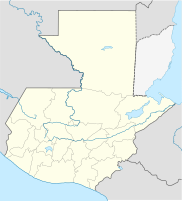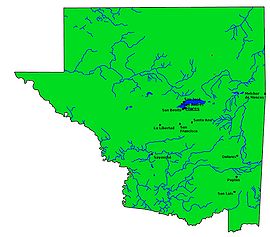San José (Peten)
| San Jose | ||
|---|---|---|
|
Coordinates: 16 ° 59 ′ N , 89 ° 55 ′ W San José on the map of Guatemala
|
||
| Basic data | ||
| Country | Guatemala | |
| Department | Peten | |
| City foundation | May 13, 1697 | |
| Residents | 4414 (2005) | |
| - in the metropolitan area | 2,000 | |
| Detailed data | ||
| surface | 2252 km 2 | |
| Population density | 2 people / km 2 | |
| height | 130 m | |
| Waters | Peten-Itzá lake | |
| Post Code | 17002 | |
| Time zone | UTC −6 | |
| City patron | San José (Festival: March 10-21) | |
| Peténs map | ||
San José (old Mayathan or Itzá name: Ixtutz , "place of the Macauba palms ") is a place in Guatemala with a population of over 2,000 . It is located in the Departamento Peten and is the administrative seat of the municipality of San José, which extends over 2,252 km² and has over 4,000 inhabitants.
geography
The place San José is located in the middle of Peten on the northwest shore of the Peten-Itzá-See at 130 m altitude. From Flores , the capital of the department on the south bank of the lake, San Andrés can be reached by road or by boat.
As with all Municipios Peténs, the main town is on Lake Petén-Itza or on a major traffic axis, while the administrative area extends far into the back, sparsely populated regions. In the case of San José, it encompasses a stretch of land the width of which is defined by the northern shore of Lake Petén Itzá. The municipality extends lengthways between the lake in the south and the border with Mexico in the north. About 80 percent of this largely of tropical rain forest -covered area are as Biosphere Reserve ( Reserva de la Biosfera Maya ) under conservation .
The neighboring municipalities are San Andrés in the west and Flores in the south and east. In the north, San José borders the Mexican state of Campeche .
history
The area around the lake was in the 12th century by the Maya -Volk the Itza settled that an independent state with its capital here to 1697 Tayasal had. The Itzá village Ixtutz stood on the site of today's San José. Several attempts at conquest by the Spaniards failed due to the fierce resistance of the Itzá. It was not until May 13, 1697 that the Spanish conqueror General Martín de Ursúa succeeded in taking Tayasal. On the same day he re-founded the town of Ixtutz with 200 people.
In 1852 Ixtutz was raised to a municipality by the government in Guatemala City and renamed San José. Up until the regional reforms in 1962, the municipality comprised much larger parts of North Petén than it does today.
population
The Municipio of San José is one of the most sparsely populated areas in Guatemala. The Itzá now make up only around a third of the total population, over 40 percent are Ladinos and the remaining quarter are Kekchí who immigrated from the south . The Itzá are concentrated in the main town, the rest of the population live in the places on the lake such as La Providencia, Playa Blanca, San Roman and Jobompiche. Other places like Corozal and smaller rural settlements and hamlets can only be reached on gravel roads or trails.
The village of San José (Ixtutz) is also the last place where the Itzá language can still be heard. While the language has not been passed on to children in other villages since the 1930s, this process did not begin until later in the more isolated San José. According to the last census in Guatemala in 2002, people referred to themselves as Itzá in 1983, but only 1094 of these gave Itzá as their mother tongue. SIL International gives only 12 fully competent speakers for 1986 and a total of 60 mostly older, no longer fully competent speakers for 1991, all of them living in San José Petén.
economy
The people in the municipality of San José live mainly from agriculture . Around half of the working population operates in subsistence farming . Mainly corn , beans and vegetables are grown . In addition, even the play and crafts , the service sector and the tourism a role.
Attractions
There are numerous Mayan ruins in the municipality of San José . The centers El Zapote, La Muralla, Zacatal, Motul de San José and El Mirador as well as Nakbé , El Guiro, Bejucal, Chachaclum, San Pedro, Uxpetén, El Astillero, Piedra Blanca, El Quetzal, Jobompiche, Cerro Cahuí, Altamira, El Palmar and El Zotz.
See also
Individual evidence
- ^ Charles Andrew Hofling: Gramática Maya Itzá, Prefacio. FAMSI 2005: Documentación Maya Itzá ( Memento of July 6, 2011 in the Internet Archive )
- ↑ XI Censo Nacional de Población y VI de Habitación (Censo 2002) - Pertenencia de grupo étnico . Instituto Nacional de Estadística. 2002. Archived from the original on February 22, 2011. Retrieved on December 22, 2009.
- ↑ XI Censo Nacional de Población y VI de Habitación (Censo 2002) - Idioma o lengua en que aprendió a hablar . Instituto Nacional de Estadística. 2002. Archived from the original on September 28, 2011. Retrieved on December 22, 2009.
- ^ A. Hofling: Ethnologue.com: Itza '- A language of Guatemala. 1991.
Web links
- Data on inforpressca.com (span.)
- Info on sanjosepeten.com (span.)

